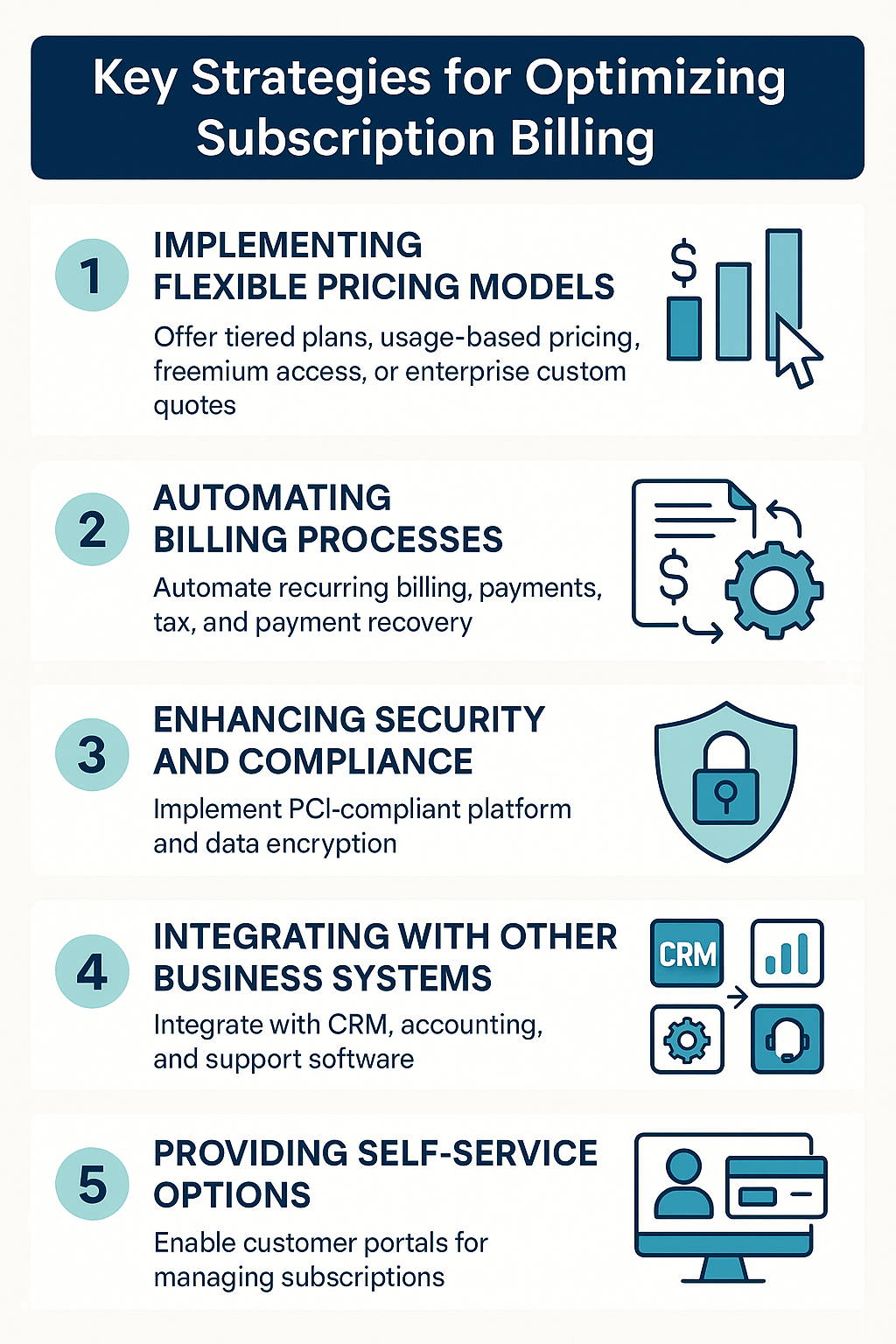.png)
In today’s competitive landscape, subscription billing isn’t just a back-office chore—it’s a strategic lever for high-growth SaaS startups aiming to scale efficiently. With a model that hinges on recurring revenue, mastering billing processes can set companies apart in an environment crowded with innovation.
Is your billing system helping you scale—or holding you back?
Many SaaS startups encounter growing pains like billing errors, failed payments, and limited flexibility in pricing. These issues can silently erode revenue and frustrate customers.
The solution lies in adopting a billing system that’s not just functional, but scalable and automated. A modern subscription billing platform enables dynamic pricing, seamless integrations, and automated workflows that reduce churn and boost operational efficiency.
In fact, industry research shows that automating billing processes can reduce churn by up to 25% and increase payment recovery rates by 30%.
In this post, we’ll explore the proven strategies high-growth SaaS companies are using to optimize their subscription billing—and how you can do the same to fuel your growth.
Understanding the Importance of Subscription Billing
Subscription billing serves as the lifeblood for SaaS companies. A robust billing system is essential not merely for collecting payments but also for nurturing customer relationships, retaining clients, and, ultimately, ensuring long-term success. By streamlining billing processes, startups can minimize churn and encourage customer loyalty, setting the foundation for sustainable growth.
Key Strategies for Optimizing Subscription Billing

1. Implementing Flexible Pricing Models
High-growth SaaS startups are quickly learning that pricing flexibility isn’t just a sales tactic—it’s a long-term growth enabler. In a competitive market where user needs and expectations vary widely, rigid pricing structures can alienate potential customers. Offering a mix of tiered plans, usage-based pricing, freemium access, or enterprise custom quotes allows startups to serve both startups with lean budgets and large enterprises with complex requirements.
Take HubSpot, for example—it begins with a free CRM but expands into multiple pricing layers across marketing, sales, and service tools. This ensures that as customers evolve, they stay within the ecosystem rather than outgrowing it. Flexible pricing fosters trust, drives lifetime value (LTV), and minimizes churn by aligning product value with customer usage and budget realities.
2. Automating Billing Processes
Manual billing might work in the early days, but it quickly becomes a bottleneck as a SaaS startup scales. Automation isn't just about saving time—it's about enabling sustainable growth and compliance at scale. With solutions like MYFUNDBOX, startups can implement end-to-end automation of billing, recurring payments, tax localization, and failed payment recovery (dunning).
Automation allows finance and ops teams to shift from reactive to proactive management. It reduces revenue leakage, ensures accurate forecasting, and enables scalable monetization. Especially in subscription-driven models where MRR/ARR tracking is crucial, automation ensures consistency, reduces human error, and increases investor confidence by delivering clean, auditable billing data.
3. Enhancing Security and Compliance
In a data-sensitive landscape, startups can’t afford to treat security as an afterthought. Customers today demand more than just product value—they want assurance that their financial and personal data is protected. Implementing PCI DSS-compliant billing platforms, encrypting customer data, and adding layers of authentication (like 3D Secure or biometric validations) is no longer optional—it's foundational.
Moreover, global compliance regulations like GDPR or the California Consumer Privacy Act (CCPA) require startups to adopt privacy-first design principles early. Companies that bake security and compliance into their billing infrastructure not only mitigate legal risks but also position themselves as trustworthy partners in the eyes of enterprise customers and regulators.
4. Integrating with Other Business Systems
Subscription billing doesn’t operate in isolation—it’s interconnected with sales, marketing, customer success, and finance workflows. Startups investing in integrations with CRM platforms (like Salesforce), accounting tools (like QuickBooks or Xero), and support software (like Zendesk or Intercom) enable data to flow seamlessly across departments.
These integrations create a holistic view of customer behaviour—from acquisition and activation to churn prediction and upselling opportunities. For instance, connecting billing data with CRM can trigger personalized engagement based on billing status or usage patterns. It also helps finance and analytics teams produce real-time dashboards tracking metrics like customer lifetime value (CLTV), churn rate, and expansion revenue—critical for agile, data-driven decisions.
5. Providing Self-Service Options
Today’s SaaS customers expect control—over their subscriptions, billing preferences, and support channels. Self-service portals aren’t just a convenience feature; they’re a driver of customer empowerment and retention. High-growth startups are embedding self-service capabilities directly into their user interface, allowing customers to manage their plans, view invoices, update payment methods, or pause/cancel subscriptions on their own terms.
Slack exemplifies this approach—users can easily upgrade or modify their plans without talking to sales. This not only streamlines customer experience but also significantly reduces support overhead and shortens resolution time. By automating routine customer tasks, startups can reallocate human resources to higher-value engagements like onboarding, success management, or enterprise expansion.
Conclusion
For high-growth SaaS startups, optimizing subscription billing is more than an operational requirement—it’s a catalyst for scale. Through flexible pricing, automation, enhanced security, smart integrations, and self-service experiences, startups can build a resilient billing system that supports their rapid growth and adapts to customer needs.
As the SaaS ecosystem continues to evolve, companies that refine and future-proof their subscription billing strategies will gain a competitive edge. Are you equipped with the right tools to scale smoothly?
Start your growth journey with MYFUNDBOX—a powerful subscription billing solution designed for automation, scalability, and seamless integration.
Whether you're handling global transactions, offering flexible billing cycles, or enhancing customer experience, MYFUNDBOX simplifies your entire billing process.
Visit www.myfundbox.com or reach out to us at support@myfundbox.com to get started
.png)
.png)















